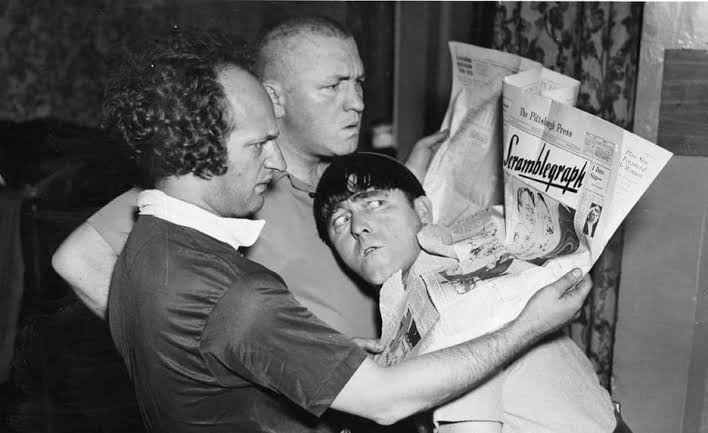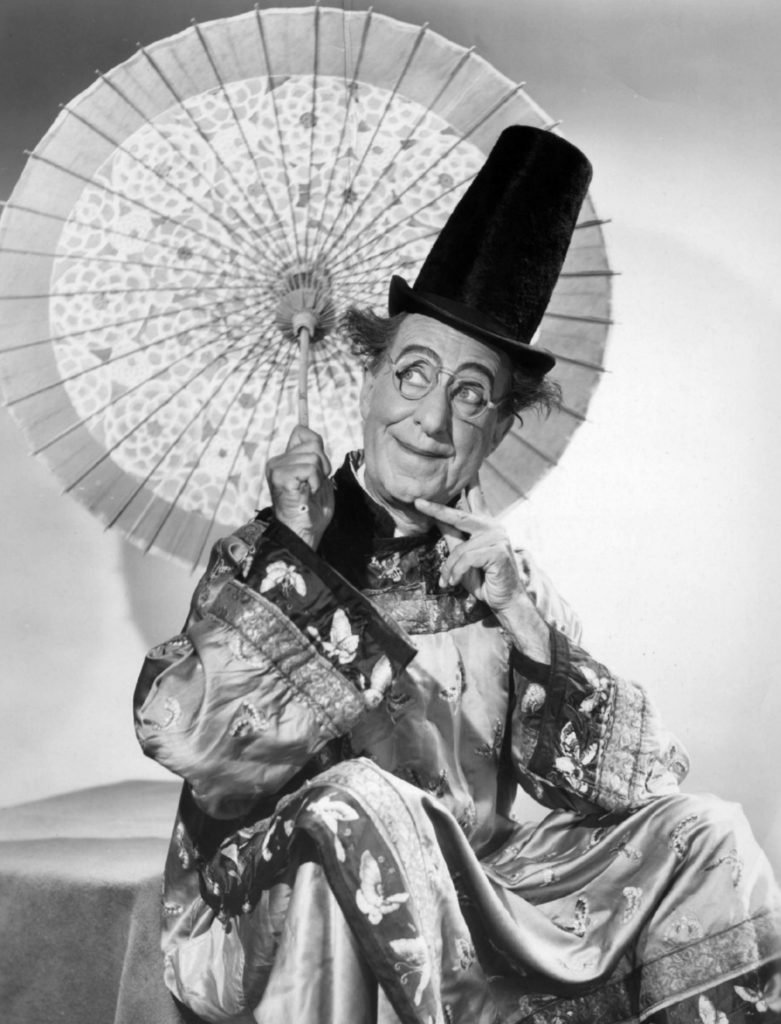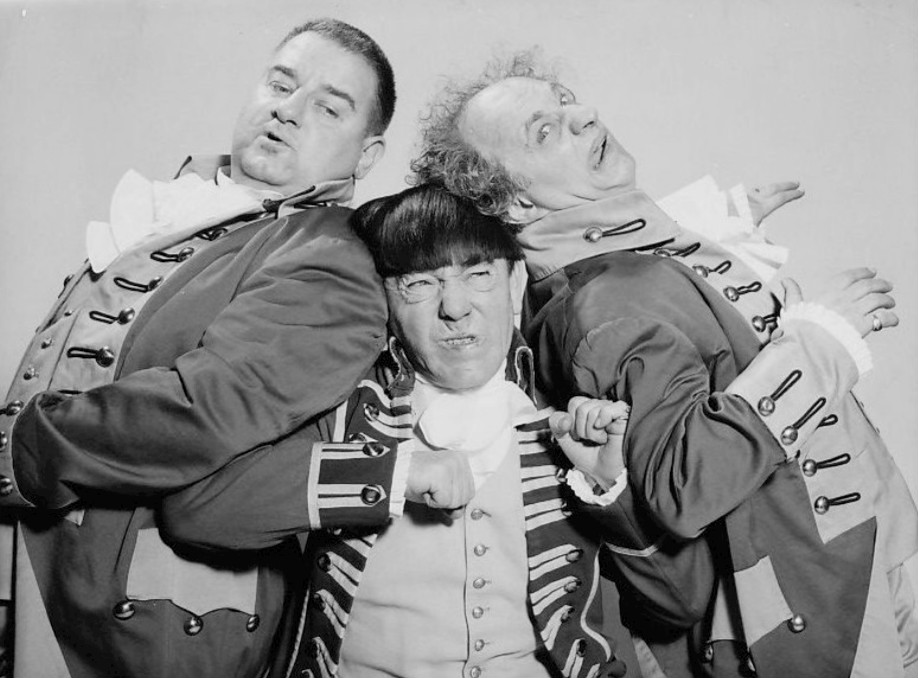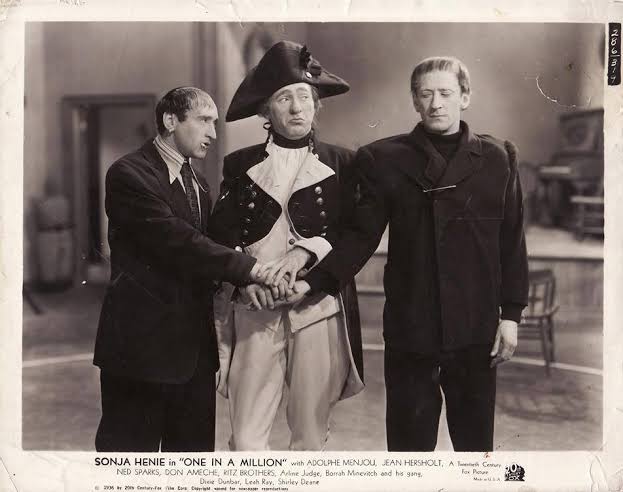Ed Wynn in photo above.
An Elephant walks into a room and nobody notices…
a slight insight into Jewish Humour in the key of b-flat.
A number of times in recent years this was said to me: “Ira, why are there so many Jewish clowns”?
After a few years I began to seek an answer. Mostly the Jewish people in the performing arts are completely the same as everyone else in the human race, and are simply trying to develop their career and opportunities. “Nothing is new under the Sun”. I don’t think I ever had a conversation with another clown who is Jewish regarding Jewish matters of any sort. I have spoken about Jewish matters with a few people who are Jewish who work in other aspects of the performing arts. ‘Jewish’ by the way can mean a 1000 different things. So too can ‘Australian’; ‘Indigenous’; ‘Gypsy’; ‘Woman’; ‘Man’ or any label that may be in part applicable to oneself.
Usually, Jewish comedy and Jewish humour are accredited to a history of being outsiders in most societies. If that may, possibly, be true for Jewish comedy and humour then it may, possibly, be true for Jewish clowns or clowning?
But, how do labels apply when many a person of our culture does not identify particularly with our Culture in any way? In fact, possibly, a very large percentage would like to not be in any way identified with any cultural label other than ‘artist’ or ‘performer’.
Then I thought about the unusual high percentage of Jewish people in most of the performing arts. I wondered in particular in what way the actual cultural source could or does contribute to our specific participation in the performing arts. Many people are separate from their connection, if any, to the said Culture. Maybe a large percentage abhors their Culture? Maybe a large percentage abhors any religious affiliation. But Jewish can be defined in various ways some of which in theory have nothing to do with the spiritual cultural practices.
Yet, such denialism has not deterred me from smelling that what some consider the most abhorrent source is the actual source of creative power. I do not expect a single Jewish person in the performing arts to agree with my viewpoints on this or any subject. Some may agree in parts, some may choose to simply disagree generally?
However, it was only yesterday that I happened to see the essay enclosed within this blog. That essay is the reason for writing this blog. The article, though a masterpiece, is steeped in cultural concepts not normally mixed with humour. A reader may benefit with a bit of an introduction. Now I will try to provide an introduction.
Spoiler Alert: it is totally verboten for me to mention a truism in the following sentence either for Jewish or non-Jewish as well as not-very-Jewish people.
In my research over the last few years, I swear, I think that the source of:
our talent in humour, comedy, clowning, as well as in drama and theatre, and, probably in any field including physics or literature; is,
both logically and magically rooted, somehow, specifically in and from the Torah.
Out of all the disagreeable things I have already written above; that last sentence will chase away most people.
For those few who remain, the rest of this blog is for your entertainment and enjoyment.
Spoiler Alert: Not one thing in Jewish culture is simple. Complexity and paradoxes may also abound in Indigenous cultures, or in any nation, or in any group.
In our Culture there is a tradition to read the entire Torah publicly and in personal study in a one-year cycle. There is a section or chapter called a parsha. Parsha is translated to portion. The plural is parshot. Those parshot are read and studied chronologically each week. Each parsha is also divided into seven sections, one for each day of the week. Like an Indigenous myth or a Vedic sutra, a parsha has almost no value until an expert presents the deeper layers of the implied or even hidden meanings. The Torah itself is written in a condensed form that originally required oral teachings to explain the meanings of each passage. Those teachings were later written and are commonly referred to, generally, as Talmud. Talmud translates to ‘study’.
Likewise, E = mc2 is an essentialised statement. It requires someone expert in the field to explain it in layman terms for most of us to get a mere layman’s understanding of its meaning and implications. There is an article “The Three Meanings of Einstein’s Equation” by Ethan Siegel, January 23, 2018 in Forbes Magazine. That article is like a hint or metaphor of a similar way of presenting the actual layers of meaning as occurs in many cultures, such as any story in Torah, or Indigenous myths, or Vedic sutras. Most artists embed hidden or implied information in their plays, novels, paintings, sculptures, films, or songs. My task in this blog is to reveal. The same is true with the article that is the highlight of this blog, it reveals but requires study to appreciate its depth hidden in humour.
Does Don Quixote as a piece of literature have any philosophical meaning for one’s life? I think it does. Does Dante’s Divine Comedy have any value for ones life? What about A Prayer for Owen Meany? Or Little Women, or Jane Austen?
Stories are essential to the human race.
I am writing October 21, 2021, that is, in the Jewish calendar, Cheshvan 15, 5782 – Parshat Vayeira.
The recent parshot include the stories of Abraham, Sarah, Lot, Hagar, Ishmael, and Isaac.
For this blog and the article the central word is ‘isaac’.
The word ‘isaac’ means to laugh. Or more specifically, ‘he will laugh’. The more accurate Hebrew transliteration of isaac is yi-tzchak. The ‘yi’ implies ‘he will’. The ‘tzchak’ implies laugh; to laugh; laughter. Together yi-tzchak is ‘he will laugh’.
Spoiler Alert: My actual Cultural name is: Yitzchak ben Yisroel. That is my real name. I also have a second real name: Ira Hal Seidenstein. In the past ones name in many cultures was ‘son of…’ or ‘daughter of …’. The name Johnson originally was John’s Son or Son of John; and, the Icelandic name of Siguroardottir means Daughter of Siguroar.
In my culture, one is often named after the most recently deceased Elder. My Father’s Father was Yitzchak. Yitzchak transliterates in English and Germanic languages as: Isaac. My Father’s name was Yisroel: Israel. So the transliteration of my name is: Isaac son-of Israel.
Isaac (Yitzchak) means ‘he will laugh’. It may be the original Jewish joke. Or at least the first connected specifically to laughter as the result of being told something. It tzchak/Yi-tzchak is mentioned several times in two forms in the early parshot of the Torah. The two forms are: the mentioned pronoun Isaac; and, tzchak as in ‘laughter’, arguably a noun.
In the Torah story, the myth if you like, old Abraham is told that he will have another son and is to name him Isaac. In the story Abraham is told by You-Know-Who, or what one friend refers to as “The Big Spaghetti Monster in the Sky”. Honest Abe is told he is not too old to have another son, and Abe laughs. That’s in the Torah. Very close to the beginning. In Book 1, Bereshith (known in English as Genesis). In the next chapter after Abe is told, he is then to tell his wife Sarah: ‘guess what’. And she laughs (tzchak). Shortly thereafter in the same chapter Lot is told some things by You-Know-Who and Lot laughs. But he is not he who laughs last.
As my myth goes, apparently my parents ‘laughed’ to find suddenly they were pregnant 7 years after my Sister was born. My parents were already ‘old’ when they got married. Still they were only half the age of Sarah and Abraham.
It was obvious by the time I was 5 years old that I was a bit of clown. I entered school Grade 1 when I was 5 and each afternoon after I walked home by myself, I would then make something to eat, and I would watch The Three Stooges on TV. I did that Monday to Friday from the age of 5 to 8. When I was 8 I had to go to an afterschool school. I was enrolled to learn Hebrew to prepare for my Bar Mitzvah at age 13. I did not fit into school, neither public school nor Hebrew school. I was a terrible student because I did not study. During most classes I was daydreaming. At least some of that time perhaps I would be dreaming about being a clown or being a 4th Stooge. When I was 9 The Three Stooges came to Pittsburgh and my Father arranged for us to meet them in their hotel’s foyer. There for about 10 minutes of talk between them and my Father, then suddenly The Three Stooges started to improvise and slap and insult each other about one yard (metre) in front of me. I had entered the Gates of Clown Heaven.
The original Three Stooges were the brothers Moe and Shemp, and their friend Larry Fine. After Shemp, came Curly pictured below. Then Curly Joe that was Joe Besser. Last when I met them was Joe de Rita (he is in the 2nd photo), with Moe and Larry.

I grew up with minimal Jewish education.
Some people who had quite a bit of Jewish education rejected nearly every aspect of our Culture and its wisdom tradition. For their own rational reasons. Yet, is it possible that they threw out the baby with the bathwater? Many people such as myself are actively making a personally challenging effort to learn what others rejected. The effort to learn or recover what was lost is called ‘teshuvah’. Teshuvah means ‘return’. It is not a new phenomenon. It has occurred in every generation for millennia. Similarly, Indigenous peoples are in processes for the first time to ‘return’. Teshuvah is actually a norm in our culture.
Recently, I explained that people like me who had little cultural knowledge were “Lox & Bagel Jews”. For us, we were born Jewish according to the culture’s definition. But the essence, so to speak, of our culture was to go to a Jewish deli that was not exactly of a high Kosher standard, there one of the favourite dishes was a lox & bagel sandwich. The second major essential of cultural identity was to note, mention, and celebrate all of the famous performing artists and others who were Jewish.
On the other hand a large percentage of Jewish people had much more connection to traditional Jewish practices.
Yes, also, we did have some authentic practices in my family. That included a Kosher home. More or less. A perpetual Friday meal together and an Eastern Europe style brunch on Sunday. In the Jewish culture the week ends Saturday night and thus is the beginning of our week. We also celebrated the High Holidays. Really though, those few things I mention are a bare minimal norm.
Let me remind that Jewish can mean 1000 different things.
Jewish people in the performing arts as well as sciences and humanities etc may or may not identify with being Jewish and even if they do ….. that can mean 1000 different things.
Jewish ‘clowns’ commonly may be seen to have begun in Vaudeville. In Vaudeville a few of the most successful clowns were: Al Jolson, Eddie Cantor, George Jessel, Milton Berle, Jack Benny, Fanny Brice, Bert Lahr, Ed Wynn, and a long list of other Jewish entertainers. To be sure the majority of entertainers were not Jewish and that included other great Vaudeville comedians and clowns in all their variety. A few of those were: Bert Williams, Will Rogers, W.C. Fields, Bob Hope, Charlie Chaplin, Stan Laurel, Buster Keaton.
As the Vaudevillians were just professionals they also worked together. For example when Eddie Cantor was in the Ziegfeld Follies he did some acts together with his mentors, Burt Williams, and Will Rogers. One of most incredible duets was Gracie Allen (not Jewish per se) and George Burns. Many years later other great comedy couples included: Stller & Meara; Sid Caesar & Imogen Coca; Nichols & May.
The next overlapping phase was Hollywood and The Marx Brothers, The Ritz Brothers, The Three Stooges who began in Ted Healy and His Stooges, there were others. There were Burlesque clowns including Phil Silvers, Pinky Lee, Irving Benson. There were many others who transitioned to Radio, TV, and cinema.
Jewish humour and clowning was embedded, somehow, in the whole careers of Sid Caesar, Mel Brooks, Woody Allen, Jerry Lewis, Adam Sandler, Sasha Baron Cohen, Matt Lucas of Little Britain, Adam Sandler, and less obvious Jack Black, Phylis Diller, Totti Fields, Joan Rivers, Gilda Radner, the main actors of Seinfeld, the creators of Schitt’s Creek – to mention only a few.
pictured below are The Ritz Brothers
However, there were cultural comedians/clowns in the Yiddish Theatre in plays that included a variety of fools. There were the cultural clowns found in Purim shpiels, Klezmer bands, as well as the wedding clowns known as badchens. Some medieval rabbis were said to have a jester. And some rabbis were known for their use of humour. One rabbi used humour too much and became a comedian, that was Jackie Mason.
My current research is for my third book. I do not have a deadline for that book. The book is the autobiographic spectrum of encountering my own culture in various absurd circumstances. The stepping off point was the question posed to me about the source of Jewish clowns. In the process I have also been researching the same source as the unmentionable secret of Jewish theatrical creativity. Although, of course Western Theatre stems largely from its origins in ancient Greek theatre. The Greek theatre itself stems from indigenous religious rites. Religious rites in every culture are theatrical performances. This is true to of the Jewish record of the rites of sacrifices. In recent years there are archeological findings on a large scale in Jerusalem which validate the related description in the Torah. It is estimated that the main site was established or begun roughly around 1000 B.C.E. After the destruction of the Second Temple the sacrifices were transformed into the beginnings of our now common practices. Interesting, for anyone who has ever participated in ritual practices, things go askew. Comedy appears. Even, for example, in a yoga class that may ritualistically begin with Surya Namiskar (Sun Salutation) there is the great fear early in the morning that someone may fart during Surya Namiskar. There goes the ritual. No. Stiff upper lip, to prevent a tzchak from erupting out ones other end even if one has to bite one’s lip. Keep calm and carry on.
To anchor my research in the actual practices of my culture, I became an official member of a local synagogue for the first time in my adult life. The daily morning service replicates the Temple service, especially on those days when the Torah scroll is brought out from the Ark and placed on the bema (podium) to be read aloud. It’s all ritualistic, a rite, and a celebration. It is a form of acting, drama, and theatre with a variety of roles.
Spontaneously… DAILY … there is humour, larking, larrikins, clowning mixed in with austere respect and ones individual natural sense of awe. It is totally theatrical. Some things I watch from the wings and other moments I am deep in some beyond. I’m learning. I enjoy the experience. It’s a form of fun. It’s a direct encounter with contemplating the Great What The…:) I also refer to the morning sessions as my Men’s Shed. There are occasionally women who are always welcome.
Our local community is dispersed over a large area of a large city. The traditional mainstay of the culture on a community level is morning practice or worship for lack of a better word. Certain rites require, traditionally speaking, a group of ten men. That group is called a minyan.
Because of the distance of members homes we barely make a minyan during the weekdays. There are a few people who aren’t officially Jewish. Though they are not officially part of the minyan, they are definitely part of the congregation. Also, the CBD location of the synagogue means that Monday to Friday parking on the street has to be cleared by 7am. So the morning session begins at 6am. For me that means getting up about 5am and out the door and onto my bicycle by 545am. Others have the same situation even though they drive. After the morning session, called shakrit (morning), there’s a super short lesson then usually some chitchat then I scoot to either swim laps or do a cycling workout.
The great article below, by Rabbi Menachem Nissel, is culturally specific. If you don’t get stuck with the few dozen culture words, you will see he’s a wonderful and enjoyable writer steeped in our Cultural knowledge. I need to go through it a few times, and I’ll need to look up many of the references. My preferred go-to site for any questions or even just word translations is Chabad.org. I’ll try to add a glossary this week. For example, Shlomo Hamelech mentioned early in the article, a Hebrew name translates to Solomon the King I.e. King Solomon.



